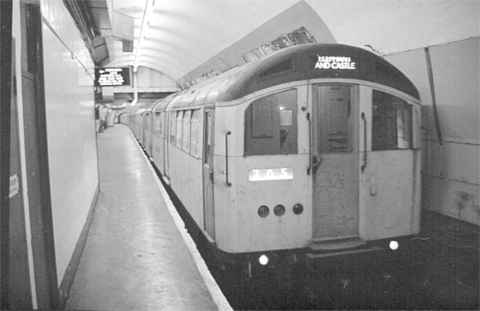
The R. J.
Waterhouse Web Site |
This page is best viewed with an 800 x 600 pixels or greater viewing area

The classic 1938 stock-inspired appearance of the 1956, 1959 and 1962 tube stocks is no longer to be seen in passenger service on the London Underground, the last 1959 stock trains on the Northern Line now replaced by the new Jubilee Line-lookalike trains. From the brief era in which 1959 stock worked on the Bakerloo Line, south-facing driving motor car 1143 is seen at Elephant And Castle on 26th February 1989. Later that year all remaining 1959 stock on the Bakerloo was replaced by 1972 Mark II stock, and returned to the Northern Line.
Hello, and welcome to the R.J. Waterhouse Web Site's London Underground Photo Page.
It's fair to say that I was
best known as a bus photographer, but there was the odd occasion
that I turned my attention towards London's Underground system.
Good thing too, because I've recorded for posterity some never-to-be-seen-again
images of the Underground system that Londoners know and -
nowadays - hate, when the most common appearance of the tube
train was that of the 1959 /62 stocks (see the photo at the top)
and the noises the trains made were an assorted array of hisses,
creaks and clunks. Today the noise you hear on the Tube is
usually 'bleep-bleep-bleep-bleep-bleep-bleep-bleep-bleep', or a
computerised voice that says "This-is-Oxford-Circus-change-at-Oxford-Circus-for-Central-and-Victoria-
Line-services", or "Thank you for travelling on the
Central Line" or whatever.
And remember that lovely, tuneful whine of the motors on a District Line R stock train? Some say that was unpleasant, but it was a lot more musical than some of today's pop music. Up until the mid-1990's you could still hear that if you were lucky enough to catch one of the remaining 1956 stock trains on the Northern Line.
Now, as we start the new Millennium, the only pre-1990 stock passenger-carrying trains on the system that remain in original condition (i.e. unpainted aluminium) are of the District Line's D stock, so far yet to be fitted with 'bleeping' doors or computerised voices. No doubt that will change before much longer.
And the oldest trains on the four rails are of another of the 'Surface' types, the A stock on the Metropolitan and East London Lines, built in 1960 /62. Also the most comfortable stock on the Tube, the A stock was given a new lease of life when the fleet was comprehensively refurbished during the early-to-mid 90's, and it is expected to last until well into the new century.
What a contrast the A stock makes with the Jubilee Line's 1996 stock at the new Canada Water station - a type of rolling stock that was around at the same time as pre-1938 tube stock and the F, O, P and Q surface stocks (it replaced the F and P stocks on the Uxbridge branch of the Met) on one level, and at the foot of the stairs, the platforms of the new Jubilee Line Extension to Stratford, with platform edge doors that open only when one of the line's thoroughly modern trains has arrived (but in practice they don't always open when they should).
Unfortunately there are no shots of the pre-1938/F/O/P/Q stocks mentioned above on this page, but here are a few reminders of what the Tube looked like in the late 80's to early 90's. The photos are taken at around the same time as my bus stuff, i.e. between 1986 and 1993. If you have any queries or questions - or you just want to tell me how good or bad the site is - feel free to E-mail me (please keep it clean).
Tube Stock photographs - scroll down: Surface Stock photos - click here: Ancillary Stock - click here
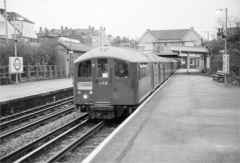 The decision to reinstate five
trains of withdrawn 1938 stock to the Northern Line during 1986
in order to increase services created a photo opportunity not to
be missed as far as I was concerned. Lots of enthusiasts may have
photographed the '38 stock on the Northern before original
withdrawal in 1978, but I was only seven years old at that time,
so being able to get out with a camera eight years later and take
shots of the best-loved London Underground train type of all time,
in service, meant a lot to me. Here arriving at Totteridge on 18th
December 1986, driving motor car 11297 heads up a seven-car train.
The decision to reinstate five
trains of withdrawn 1938 stock to the Northern Line during 1986
in order to increase services created a photo opportunity not to
be missed as far as I was concerned. Lots of enthusiasts may have
photographed the '38 stock on the Northern before original
withdrawal in 1978, but I was only seven years old at that time,
so being able to get out with a camera eight years later and take
shots of the best-loved London Underground train type of all time,
in service, meant a lot to me. Here arriving at Totteridge on 18th
December 1986, driving motor car 11297 heads up a seven-car train.
The other end of that train, photographed at one of the northern extremities of the line, High Barnet. Facing south, driving motor car 10205 will head up the train on its last morning peak trip to Morden and is nearly ready to depart - 'Wait for me!' On the right is an interior view of 10205, looking towards the driver's cab. Just look at those light bulbs!
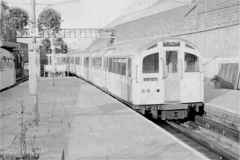 The prototypes for the next
generation of Tube stock, which was to replace the pre-1938 stock
on the Piccadilly and Central Lines, were the three 1956 stock
trains, which spent the first half of their lives on the
Piccadilly Line and the second half on the Northern. This was the
first tube stock to use fluorescent lighting, and the last to
feature deep, comfy seat cushions. Facing south, driving motor
car 1011 is at the back of a Mill Hill East train departing
Morden on 5th November 1990, by which time the original five-light
arrangement, as used on the 1938 stock , had been superseded by
powerful twin headlights.
The prototypes for the next
generation of Tube stock, which was to replace the pre-1938 stock
on the Piccadilly and Central Lines, were the three 1956 stock
trains, which spent the first half of their lives on the
Piccadilly Line and the second half on the Northern. This was the
first tube stock to use fluorescent lighting, and the last to
feature deep, comfy seat cushions. Facing south, driving motor
car 1011 is at the back of a Mill Hill East train departing
Morden on 5th November 1990, by which time the original five-light
arrangement, as used on the 1938 stock , had been superseded by
powerful twin headlights.
A seven-car 1959 stock train on the Northern Line, headed up by south-facing driving motor 1067, departing Edgware on 7th June 1990.
Two shots of the Central Line's 1962 stock. On the left is driving motor 1460, in original condition, about to head up a West Ruislip train at Epping on 31st July 1987. On the right, taken from the bridge over Newbury Park station, car 1531 leads an Ealing Broadway train on 24th October 1992, having been fitted with improved safety measures : the most obvious visual evidence of this is the receptacle box and piping, which gives this train an untidy appearance.
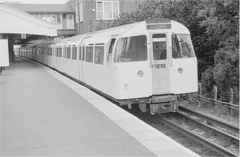 The first order of 1972 stock,
designated 'Mark I', was similar in appearance to the 1967 stock
operating on the Victoria Line. It was allocated to the Northern
throughout its life until a few trains were converted and
refurbished to work with the '67 stock, providing extra trains
for the Victoria, in the late 80's. In original condition, car
3210 heads up a northbound train at Burnt Oak on 7th June 1990.
This unit was overhauled at Stonebridge Park depot and carries a
small hexagon-shaped 'SP' logo which denotes that, located on the
train front at the bottom left.
The first order of 1972 stock,
designated 'Mark I', was similar in appearance to the 1967 stock
operating on the Victoria Line. It was allocated to the Northern
throughout its life until a few trains were converted and
refurbished to work with the '67 stock, providing extra trains
for the Victoria, in the late 80's. In original condition, car
3210 heads up a northbound train at Burnt Oak on 7th June 1990.
This unit was overhauled at Stonebridge Park depot and carries a
small hexagon-shaped 'SP' logo which denotes that, located on the
train front at the bottom left.
The second 1972 batch, referred to as, would you believe, 'Mark II', differed in appearance from the Mark I batch in that the doors were painted red. This stock has worked on the Bakerloo, Jubilee and Northern Lines in its time and survives, refurbished and painted in corporate livery, on the Bakerloo today. Illustrating the Mark II stock on the Jubilee Line and in original condition, south-facing driving motor 3542 is seen at the rear of a train at Wembley Park in 1987. The Mark II stock was gradually made suitable for one-person-operation during the period in which it was transferred to the Bakerloo and the most noticeable visual difference was the introduction of a liquid-crystal train number display. Car 3556 is seen on the Bakerloo at Harrow And Wealdstone on 7th June 1990.
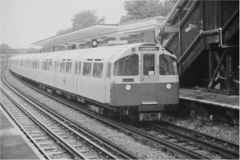 Whenever you saw an advert for a
'Cheap Day Return' - it saved getting the car out, apparently -
in the 70's, the train visible in the garage while the bloke was
shutting the door looked like this. A photo of the Piccadilly
Line's 1973 stock, bought for the Heathrow extension and to
replace 1959 stock, always featured in promotional material of
the time. The stock has been refurbished, as has every other
passenger-carrying pre-1990 tube stock, and no unpainted tube
stock trains are in service now. This is the last unit of 1973
stock, car 895 at the head of an eastbound train : this was half
of the 'Experimental Tube Train' (892-692- 893+894-694-895),
kitted out with various components to provide useful information
for new Jubilee Line stock . This unit was delivered in 1979 and,
after it had served its initial purpose, entered service in 1986.
Photographed at South Ealing on 3rd August 1987.
Whenever you saw an advert for a
'Cheap Day Return' - it saved getting the car out, apparently -
in the 70's, the train visible in the garage while the bloke was
shutting the door looked like this. A photo of the Piccadilly
Line's 1973 stock, bought for the Heathrow extension and to
replace 1959 stock, always featured in promotional material of
the time. The stock has been refurbished, as has every other
passenger-carrying pre-1990 tube stock, and no unpainted tube
stock trains are in service now. This is the last unit of 1973
stock, car 895 at the head of an eastbound train : this was half
of the 'Experimental Tube Train' (892-692- 893+894-694-895),
kitted out with various components to provide useful information
for new Jubilee Line stock . This unit was delivered in 1979 and,
after it had served its initial purpose, entered service in 1986.
Photographed at South Ealing on 3rd August 1987.
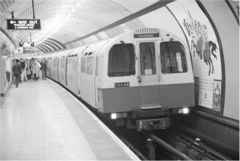 The result of the research and
testing using the Experimental Tube Train was the 1983 stock,
delivered for the Jubilee Line in two batches which entered
service in 1984 and 1987 respectively. Seemingly regarded as a 'non-standard'
type of rolling stock, and with stations on the Jubilee Extension
kitted out with platform edge doors, the 1983 stock ended up
replaced by the 1996 stock and was not redeployed. Some 1983
stock trains were sitting derelict in Uxbridge sidings in the
early months of 2000 (and still were in May). Facing south,
driving motor car 3627 is seen at Charing Cross, the then
southern terminus of the Jubilee which ceased to be served by it
upon the opening of the extension, on 20th November 1987.
The result of the research and
testing using the Experimental Tube Train was the 1983 stock,
delivered for the Jubilee Line in two batches which entered
service in 1984 and 1987 respectively. Seemingly regarded as a 'non-standard'
type of rolling stock, and with stations on the Jubilee Extension
kitted out with platform edge doors, the 1983 stock ended up
replaced by the 1996 stock and was not redeployed. Some 1983
stock trains were sitting derelict in Uxbridge sidings in the
early months of 2000 (and still were in May). Facing south,
driving motor car 3627 is seen at Charing Cross, the then
southern terminus of the Jubilee which ceased to be served by it
upon the opening of the extension, on 20th November 1987.
These trains were sitting derelict within five years of delivery. The three four-car units known as the 1986 Prototype Tube Stock were the mobile test beds for the Central Line's 1990 stock, and a lot of new features trialled on the 1986 stock were incorporated into the Central's new trains, such as grab rails instead of the traditional strap-hangers for standing passengers and those blasted bleeping doors. Based on the Jubilee Line at Neasden depot, they were seldom used in passenger service and it won't surprise you to learn that these trains were not in service when photographed: infact a decision to withdraw the stock from passenger use was taken when a train derailed at Neasden in the summer of 1989, featuring subsequently on local television news reports. The three trains were partially painted, and - when in service - operated in colourful six-car formations, two cars of each of the three types. Here they are, with (from left to right) the red train, driving motor 11 nearest the camera, at South Ealing (on the test tracks) on 21st August 1987: the blue train, with north-facing car 13 at the rear, exiting Queensbury on 6th May 1988: and the green one - all four green cars are in this train - with car 16 heading it up at Kingsbury on 20th March 1988.
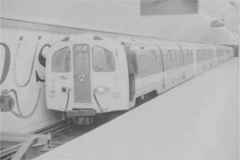 Not part of the London
Underground on 19th December 1986, the date of the photo, the
railway they call 'The Drain' is now officially part of it, and
though strictly speaking this shot doesn't belong here, I can't
put it in any of my bus pages! This was the period when the
Waterloo And City Line was under the auspices of Network South
East (remember them?) and it seemed the 1940-built class 487
units that operated it would go on for ever. They were withdrawn
in 1993 whilst the line was subjected to engineering works, and
when reopened it had been converted from third rail to fourth and
was operated by 1990 stock trains, identical (apart from livery)
to the Central Line's new stock. This five-car class 487 set is
about to depart Bank.
Not part of the London
Underground on 19th December 1986, the date of the photo, the
railway they call 'The Drain' is now officially part of it, and
though strictly speaking this shot doesn't belong here, I can't
put it in any of my bus pages! This was the period when the
Waterloo And City Line was under the auspices of Network South
East (remember them?) and it seemed the 1940-built class 487
units that operated it would go on for ever. They were withdrawn
in 1993 whilst the line was subjected to engineering works, and
when reopened it had been converted from third rail to fourth and
was operated by 1990 stock trains, identical (apart from livery)
to the Central Line's new stock. This five-car class 487 set is
about to depart Bank.
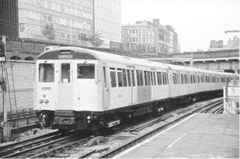 Now the oldest passenger stock on the
Underground, the A stock on the Metropolitan Line is pushing 40
years old and has every chance of reaching 50, possibly even 60.
It will have to last that long to justify the money spent on
refurbishing it during the 90's - and yours truly hopes that it
does so. In an effort to improve the appearance of the stock,
which at the time suffered more than any other stock from
graffiti, some trains overhauled by Neasden depot appeared with
maroon or red roofs during 1987/88, unit 5092-6092- 6093-5093 the
first. Here is that unit, with 5093 nearest the camera, at the
rear of a train at Farringdon on 29th July 1987. The driving
motors also have a grey middle lower panel with an 'Underground'
roundel on it, replacing the 'London Transport' underlined
fleetname.
Now the oldest passenger stock on the
Underground, the A stock on the Metropolitan Line is pushing 40
years old and has every chance of reaching 50, possibly even 60.
It will have to last that long to justify the money spent on
refurbishing it during the 90's - and yours truly hopes that it
does so. In an effort to improve the appearance of the stock,
which at the time suffered more than any other stock from
graffiti, some trains overhauled by Neasden depot appeared with
maroon or red roofs during 1987/88, unit 5092-6092- 6093-5093 the
first. Here is that unit, with 5093 nearest the camera, at the
rear of a train at Farringdon on 29th July 1987. The driving
motors also have a grey middle lower panel with an 'Underground'
roundel on it, replacing the 'London Transport' underlined
fleetname.
The A stock also works on the East London Line in single four-car units, which it has done between 1977 and 1985, and from 1987 to the present day (the District Line's D stock was in situ for the period in between). Heading up a northbound train, car 5060 enters Rotherhithe on 30th July 1987. This unit was for some time fitted with experimental braking equipment of Davies and Metcalfe manufacture, and confined to the East London Line amd the Chalfont-Chesham shuttle whilst so fitted.
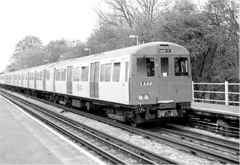 The
East London Line trains became the first painted A stock during
1988 /89. Sponsored by the London Docklands Development
Corporation, whose logo this train carries, the various liveries
that appeared on them ended up being part of London Underground
livery experiments to decide on a corporate colour scheme, which
of course is how the current livery of white with red front and
doors and a blue skirt came about. The first painted four-car
unit to appear was 5066-6066-6067-5067 in November 1988, and here
it is - many miles away from its home line, heading up a Baker
Street train on the Metropolitan Line on 16th April 1989! It's at
Ruislip Manor, with car 5067 nearest the camera.
The
East London Line trains became the first painted A stock during
1988 /89. Sponsored by the London Docklands Development
Corporation, whose logo this train carries, the various liveries
that appeared on them ended up being part of London Underground
livery experiments to decide on a corporate colour scheme, which
of course is how the current livery of white with red front and
doors and a blue skirt came about. The first painted four-car
unit to appear was 5066-6066-6067-5067 in November 1988, and here
it is - many miles away from its home line, heading up a Baker
Street train on the Metropolitan Line on 16th April 1989! It's at
Ruislip Manor, with car 5067 nearest the camera.
An interior view of A stock in 'almost-original' condition, looking towards the driver's cab - 'almost' because the original line diagram has been replaced with one incorporating the East London Line, then known as 'Metropolitan Line - East London Section'. Taken in 1987.
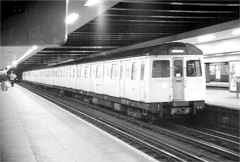 Also now completely refurbished
is the C stock, which has operated the Circle and Hammersmith And
City Lines since 1970 and the Wimbledon to Edgware Road section
of the District Line since 1977. When delivered, the first batch
(C69 stock) had black-painted roofs, while the second (C77 stock)
had unpainted roofs. Facing west, reversible driving motor 5601
heads up a Circle Line train at Moorgate on 20th November 1987.
Also now completely refurbished
is the C stock, which has operated the Circle and Hammersmith And
City Lines since 1970 and the Wimbledon to Edgware Road section
of the District Line since 1977. When delivered, the first batch
(C69 stock) had black-painted roofs, while the second (C77 stock)
had unpainted roofs. Facing west, reversible driving motor 5601
heads up a Circle Line train at Moorgate on 20th November 1987.
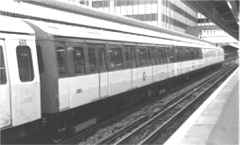 The prototype for C stock
refurbishment was the mixed C69/77 unit, motor car 5585 and
trailer 6585. The original 5585 was scrapped following a bomb
incident in the mid-70's and was replaced by a new C77 driving
motor, tagged onto the main C77 stock order. The refurbished unit
was displayed to the public at Hammersmith (Hammersmith And City
Line) station on 22nd September 1989, and here it is -
unfortunately for photography purposes situated in the middle of
this train! The livery, along with the 'blue doors' colour scheme
depicted earlier, was another of the 'rejects' - it consists of a
red front, grey roof, blue top-half and white below the waist. It
was re-refurbished later on to bring it into line with the
remainder of the C stock.
The prototype for C stock
refurbishment was the mixed C69/77 unit, motor car 5585 and
trailer 6585. The original 5585 was scrapped following a bomb
incident in the mid-70's and was replaced by a new C77 driving
motor, tagged onto the main C77 stock order. The refurbished unit
was displayed to the public at Hammersmith (Hammersmith And City
Line) station on 22nd September 1989, and here it is -
unfortunately for photography purposes situated in the middle of
this train! The livery, along with the 'blue doors' colour scheme
depicted earlier, was another of the 'rejects' - it consists of a
red front, grey roof, blue top-half and white below the waist. It
was re-refurbished later on to bring it into line with the
remainder of the C stock.
Once you see one of these trains, you've seen 'em all. At the time this page was constructed, none of the District Line's D stock trains have yet had their exterior or interior appearances altered significantly, so what they looked like in 1987 - the year this photograph was taken - they look like today. Facing east, driving motor 7023 is at the back of a train departing Whitechapel on 30th July.
Some photos illustrating some of the engineers' trains that keep the London Underground the well-oiled machine that it is (perhaps that should be well-electrified!)
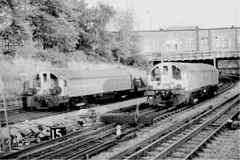 If
you're waiting for the late-night tube home, then you have a good
chance of seeing a wagon train, with a battery locomotive at each
end, passing through before your train does. That could get you
thinking that you've missed the last train! Here are two battery
locos at Harrow-on-the-Hill, just south of the station, occupying
both southbound tracks during Metropolitan Line engineering works
on 4th October 1986. On the left is no. L38, built in 1938 by the
Gloucester Railway Carriage and Wagon Co., and on the right is L27,
a Metro-Cammell product of 1965 manufacture.
If
you're waiting for the late-night tube home, then you have a good
chance of seeing a wagon train, with a battery locomotive at each
end, passing through before your train does. That could get you
thinking that you've missed the last train! Here are two battery
locos at Harrow-on-the-Hill, just south of the station, occupying
both southbound tracks during Metropolitan Line engineering works
on 4th October 1986. On the left is no. L38, built in 1938 by the
Gloucester Railway Carriage and Wagon Co., and on the right is L27,
a Metro-Cammell product of 1965 manufacture.
More engineering works, at Golders Green this time on 11th October 1986. A diesel crane built by Cowans and Sheldon, C626, is hard at work - well, at work anyway.
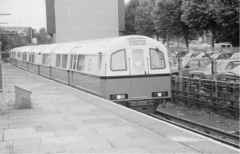 What the Track Recording Train
does isn't videotaping the track below with a camcorder - it
monitors track condition and records data. The train consists of
converted 1960 stock driving motors at either end, with a 1973
stock trailer in the middle - this car contains the equipment and
computers that do the job. Facing west, L133 heads it up as it
passes through Leytonstone on 31st July 1987, in white and red
livery with a black band. It's in corporate livery nowadays.
What the Track Recording Train
does isn't videotaping the track below with a camcorder - it
monitors track condition and records data. The train consists of
converted 1960 stock driving motors at either end, with a 1973
stock trailer in the middle - this car contains the equipment and
computers that do the job. Facing west, L133 heads it up as it
passes through Leytonstone on 31st July 1987, in white and red
livery with a black band. It's in corporate livery nowadays.
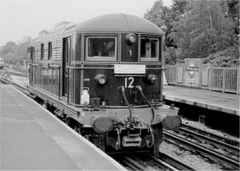 'Coming through . . . '
Unquestionably the big daddy of ALL working stock on the
Underground when photographed, this is the awesome and
immediately recognisable figure of no.12 'Sarah Siddons', the
last surviving example of the 20 electric locomotives built in
1922/23 to haul Metropolitan Line compartment stock (apart from
no. 5, which is in the possession of the London Transport Museum).
Its normal job after finishing hauling passenger trains was as a
Brake Block Test Locomotive, and no.12 has been used annually on
the 'Steam On The Met' event since 1989 as well. Here she is on
the Uxbridge line at Rayners Lane on 3rd June 1987.
'Coming through . . . '
Unquestionably the big daddy of ALL working stock on the
Underground when photographed, this is the awesome and
immediately recognisable figure of no.12 'Sarah Siddons', the
last surviving example of the 20 electric locomotives built in
1922/23 to haul Metropolitan Line compartment stock (apart from
no. 5, which is in the possession of the London Transport Museum).
Its normal job after finishing hauling passenger trains was as a
Brake Block Test Locomotive, and no.12 has been used annually on
the 'Steam On The Met' event since 1989 as well. Here she is on
the Uxbridge line at Rayners Lane on 3rd June 1987.
All photos copyright R. J. Waterhouse. |
The R. J. Waterhouse Web Site is a member of these web rings:-
The British Bus Web
Ring (Previous | Next | Random Site | List Sites)
The London
Transport Web Ring
(Previous | Next | List Sites)
The Tube Ring (Previous 5 Sites| Previous | Next | Next 5 Sites | Random Site | List Sites)
| Click here to E-mail R. J. | Back to the main R. J. Waterhouse Web Site index page |